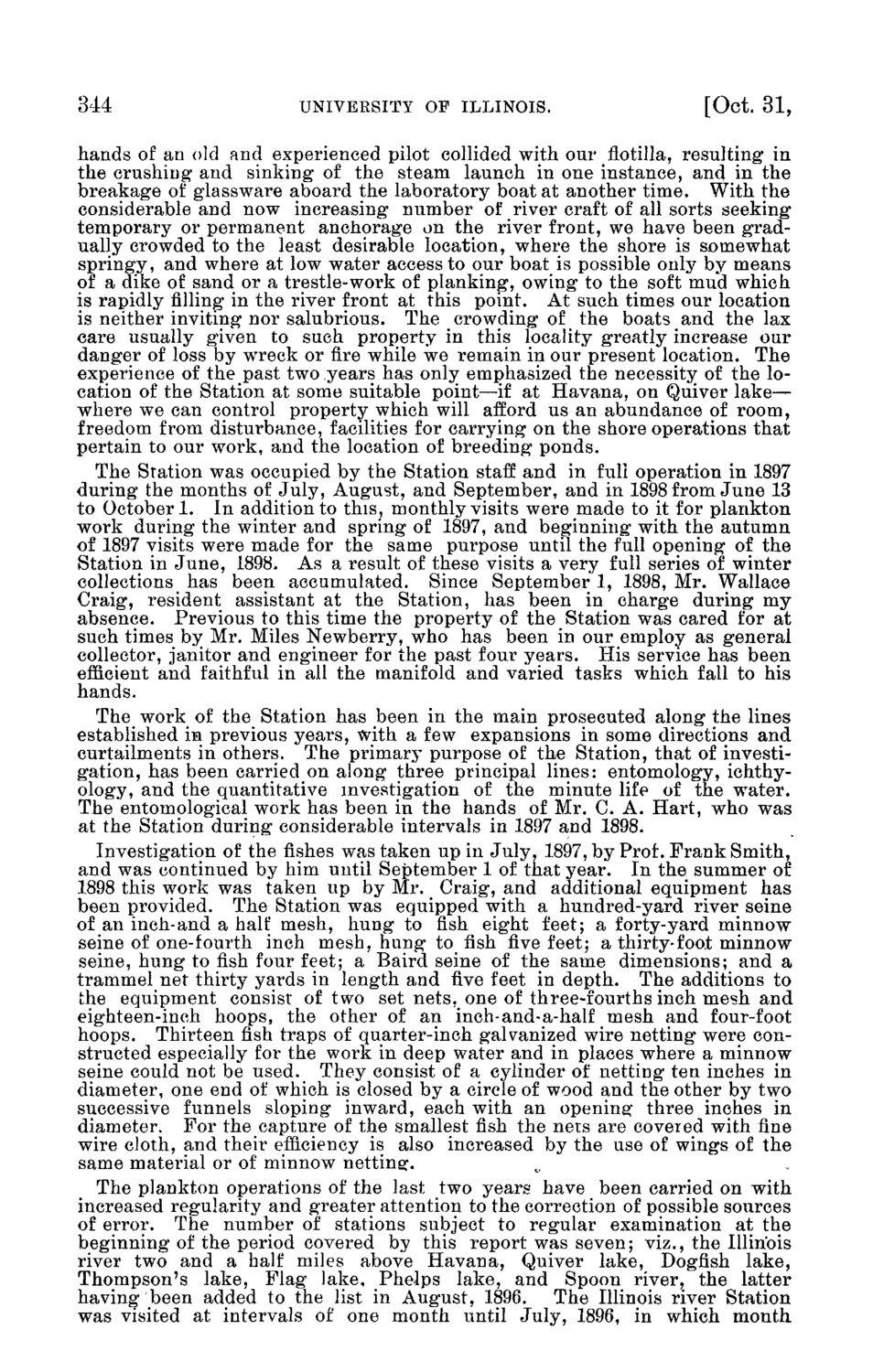| |
| |
Caption: Board of Trustees Minutes - 1898
This is a reduced-resolution page image for fast online browsing.

EXTRACTED TEXT FROM PAGE:
344 UNIVERSITY OF ILLINOIS. [Oct. 3 1 , hands of an old and experienced pilot collided with our flotilla, resulting in the crushing and sinking of the steam launch in one instance, and in the breakage of glassware aboard the laboratory boat at another time. With the considerable and now increasing number of river craft of all sorts seeking temporary or permanent anchorage on the river front, we have been gradually crowded to the least desirable location, where the shore is somewhat springy, and where at low water access to our boat is possible only by means of a dike of sand or a trestle-work of planking, owing to the soft mud which is rapidly filling in the river front at this point. At such times our location is neither inviting nor salubrious. The crowding of the boats and the lax care usually given to such property in this locality greatly increase our danger of loss by wreck or fire while we remain in our present location. The experience of the past two years has only emphasized the necessity of the location of the Station at some suitable point—if at Havana, on Quiver lake— where we can control property which will afford us an abundance of room, freedom from disturbance, facilities for carrying on the shore operations that pertain to our work, and the location of breeding ponds. The Station was occupied by the Station staff and in full operation in 1897 during the months of July, August, and September, and in 1898 from June 13 to October 1. In addition to this, monthly visits were made to it for plankton work during the winter and spring of 1897, and beginning with the autumn of 1897 visits were made for the same purpose until the full opening of the Station in June, 1898. As a result of these visits a very full series of winter collections has been accumulated. Since September 1, 1898, Mr. Wallace Craig, resident assistant at the Station, has been in charge during my absence. Previous to this time the property of the Station was cared for at such times by Mr. Miles Newberry, who has been in our employ as general collector, janitor and engineer for the past four years. His service has been efficient and faithful in all the manifold and varied tasks which fall to his hands. The work of the Station has been in the main prosecuted along the lines established in previous years, with a few expansions in some directions and curtailments in others. The primary purpose of the Station, that of investigation, has been carried on along three principal lines: entomology, ichthyology, and the quantitative investigation of the minute life of the water. The entomological work has been in the hands of Mr. C. A. Hart, who was at the Station during considerable intervals in 1897 and 1898. Investigation of the fishes was taken up in July, 1897, by Prof. Frank Smith, and was continued by him until September 1 of that year. In the summer of 1898 this work was taken up by Mr. Craig, and additional equipment has been provided. The Station was equipped with a hundred-yard river seine of an inch-and a half mesh, hung to fish eight feet; a forty-yard minnow seine of one-fourth inch mesh, hung to fish five feet; a thirty-foot minnow seine, hung to fish four feet; a Baird seine of the same dimensions; and a trammel net thirty yards in length and five feet in depth. The additions to the equipment consist of two set nets, one of three-fourths inch mesh and eighteen-inch hoops, the other of an inch-and-a-half mesh and four-foot hoops. Thirteen fish traps of quarter-inch galvanized wire netting were constructed especially for the work in deep water and in places where a minnow seine could not be used. They consist of a cylinder of netting ten inches in diameter, one end of which is closed by a circle of wood and the other by two successive funnels sloping inward, each with an opening three inches in diameter. For the capture of the smallest fish the nets are covered with fine wire cloth, and their efficiency is also increased by the use of wings of the same material or of minnow netting. The plankton operations of the last two years have been carried on with increased regularity and greater attention to the correction of possible sources of error. The number of stations subject to regular examination at the beginning of the period covered by this report was seven; viz., the Illinois river two and a half miles above Havana, Quiver lake, Dogfish lake, Thompson's lake, Flag lake, Phelps lake, and Spoon river, the latter having been added to the list in August, 1896. The Illinois river Station was visited at intervals of one month until July, 1896, in which month
| |